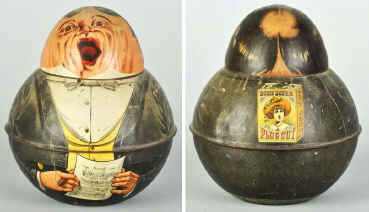|
The Tobacco Tins Many Uses
 Over the years tobacco companiesí marketing and
merchandising departments produced a dazzling array of advertising
items. With the growth of the tobacco industry, the quantity of
advertising products proliferated in proportion. From the ubiquitous
painted barn travelers see in farm country to the smallest tobacco tin,
these signs, logos, and trademarks became indelibly embedded in American
life. Over the years tobacco companiesí marketing and
merchandising departments produced a dazzling array of advertising
items. With the growth of the tobacco industry, the quantity of
advertising products proliferated in proportion. From the ubiquitous
painted barn travelers see in farm country to the smallest tobacco tin,
these signs, logos, and trademarks became indelibly embedded in American
life.
The process of lithography was patented in 1875,
creating an efficient way to print on tin, a particularly important
technique to tobacco manufacturers who needed to seal their product from
the air. Tobacco tins were manufactured in only a small number of shapes
and styles. There were cylinders and boxes used for bulk tobacco sales,
and smaller flat or concave tins for personal use designed to be carried
in a pocket. A lunchbox tin had a wire handle and was typically reused
for its namesake purpose, as was the lunch bucket. There were also
figural tins that held a pound of tobacco and were designed to sit on a
table or shelf. They were called roly polys because of their shape.
 Like any manufactured item, tobacco tins found other
uses once the product itself was exhausted. Containers are always
necessary for storage, and tobacco containers both large and small
proved very convenient. Like any manufactured item, tobacco tins found other
uses once the product itself was exhausted. Containers are always
necessary for storage, and tobacco containers both large and small
proved very convenient.
In the fifty or 60 years prior to 1940, thousands, if
not millions, of children carried their lunch to school in emptied
rectangular tobacco tins. If one were lost or destroyed, another was not
difficult to procure - if there wasn't another one already lying around
the house.
Because of the limited shapes and sizes of tobacco
tins, lithography was about the only way to differentiate products on
store shelves. There were images to appeal to everyone, birds,
butterflies, animals, hunting, cowboys, gentlemen, flowers, the more
colorful, the better.
 The most popular images were those of sailors and the
Navy. Multiple companies offered tobacco in tins covered with sea
captains at the helm, Navy vessels, ships and other manly images.
Companies targeted ladies who used tobacco with beautiful and colorful
feminine subjects on containers. The most popular images were those of sailors and the
Navy. Multiple companies offered tobacco in tins covered with sea
captains at the helm, Navy vessels, ships and other manly images.
Companies targeted ladies who used tobacco with beautiful and colorful
feminine subjects on containers.
Many people think that because something is old, itís
valuable. In tobacco tins, like most antiques, itís not the age, but
the rarity, the demand, the design, and the condition. It makes no
difference whether or not tins still contain the tobacco. Rare tins with
few known examples will naturally be more valuable. But collectors have
to want them too, so both rarity and demand are required to add value.
Collectors love tins with fine designs and lots of
color. And condition is always important in defining value. No scrapes
in the lithography, and an intact sheen to the finish are most
desirable.
Beginners can start with entry-level tins costing as
little as a few dollars. These are common and easily available brands
like Prince Albert, Velvet, and Sir Walter Raleigh. But if they have a
barcode on them, they have little value. Mid-level tins can be found
from $20-80 and include such brands as Honey Moon, Hi-Plane, Twin Oaks,
and Stag. The combination of rarity and demand can combine to drive
prices up. Those tins that donít come up for sale very often can sell
for hundreds, even thousands, of dollars. Rare tins in such brands as
Gold Dust, Shogun, Cardinal, and Rock Castle must be in good condition
with the lithography intact and colorful, without rust or dents or other
defects with a nice shine to the finish to bring top prices.
|